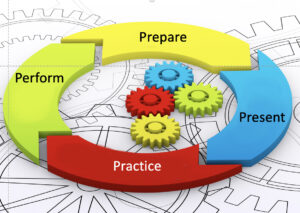Accelerate Learning With Meier’s Four Phases
 In his book, The Accelerated Learning Handbook, Dave Meier lays out 4 phases of Learning. Those of you who have heard of PDCA (Plan, Do, Check, Act) will recognize the format. It’s not exactly the same, but the flow sure feels familiar!
In his book, The Accelerated Learning Handbook, Dave Meier lays out 4 phases of Learning. Those of you who have heard of PDCA (Plan, Do, Check, Act) will recognize the format. It’s not exactly the same, but the flow sure feels familiar!
His four phases look like this…
Preparation
The goal of the Preparation Phase is to pique learners curiosity, get them feeling positive about what’s going to happen, and raise their ‘leaning quotient’. I use music, engage them early by asking for their objectives, have them create a tent card and make sure there’s enough space for their books. Make sure there are enough flip charts for 3 person teams, or enough ‘painter’s tape’ to create work spaces on the wall.
Presentation
Use the 80/20 ratio: 80% exercises and 20% lecturing. Put one sentence per slide and a visual to match the sentence (sometimes it takes longer to find the right visual that it does to present the material!). Start with something the learners KNOW then move to the new material. Use the SAVI principles from the last tip and present in a way that is interesting, enjoyable, relevant, multi-sensory, and appeals to a variety of learning styles. Have your participants review the material you’re working with and create their own group presentations. Yes, each member of your audience has a brain!
Practice
Help learners use the concepts you’re working on. You may have started this in the ‘Presentation’ phase – keep it going! Try practicing the skills you’re presenting, like interview questions in an Internal Auditor course. Participants can read a procedure and decide what they would talk about with the auditee. Let them take turns in a group of 3: Auditor, Auditee and Observer, then switch roles after 6 06 7 minutes. In 20 minutes, everyone experiences all 3 roles. Powerful! It’s what the learners do that is most important, not what we do as presenters (Win Wenger)
Performance
In the Lead Auditor course we have teams present an Opening Meeting and a Closing Meeting. This will work for just about any training topic – have the participants ‘be the teacher’ or demonstrate a skill to the whole class, not just in their groups. This is also a litmus test for the effectiveness of your training – did it work? Video taping adds an element of realism, too, in the area of ‘stress’!! This helps learners extend their new skills to the job, if you can simulate the working conditions. Probably easier to do for an ‘in-house’ or ‘on-site’ course than in a public setting, but try anyway. I have a question on my evaluation sheets: “Will you be able to use this back at work?” and request a comment either way – yes or no. This helps me find ways to improve the next one and gives us good feedback on what’s working.
Know Quality, Know Profit…No Quality, No Profit
We have an easy-to-use training tracking tool built into our Cloud-based Management System platform. If you’d like to see if it can help improve how you manage your training activities, schedule a demo. We’d be happy to spend 10 or 15 minutes with you to see if it’s a fit…
Schedule a demo
Click here to have a look at the preview for our ‘ISO 9001:2105 Essentials’ online training course:
ISO 9001 Essentials Training Course and Preview
